SAU 7,5cm Pak 40 / 4 auf gep. Selbstfahrlafette Raupenschlepper Ost: simple and useless
Recall, the RSO appeared on the results of studying the combat experience of the 1941-42 winter, when German troops suffered a lot of problems due to the specifics of the landscape of the theater of operations and excessively cold climate. In the spring of 1942, the requirements for a prospective artillery tractor were formed, which was supposed to provide mobility units in the future. This machine had to be notable for its simplicity of design, reducing production costs, to have high mobility on rough terrain, good lifting capacity and the ability to work reliably in any climatic conditions.
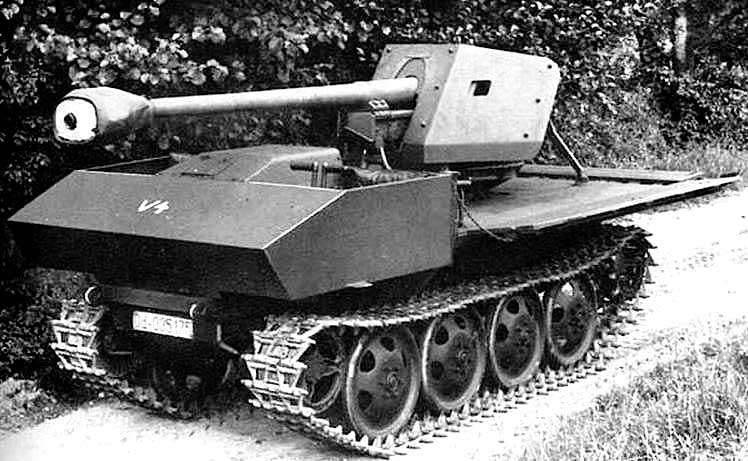
SAU 7,5cm Pak 40 / 4 auf gep. Selbstfahrlafette Raupenschlepper Ost. Photo Aviarmor.net
One of the first options for a promising machine that meets the requirements was proposed by Steyr-Daimler-Puch AG. In the summer of 42, the specialists of this company completed the design of the new tractor and developed a preliminary version of the project. By the end of 1942, the prototype of the Raupenschlepper Ost ("Tracked tractor - East") passed all the necessary tests, after which an order was issued to start the mass production of such equipment. Subsequently, the first version of the machine received the RSO / 01 symbol, which was associated with the appearance of RSO / 02 and RSO / 03 modifications, which differed from the basic version with some modifications of a technical and technological nature.
Production of RSO continued until the very end of the war in Europe. In total, more than 28 thousand of similar vehicles were assembled, which were sent to various units of the ground forces. The main task of such equipment was towing field guns, as well as transportation of their calculations and ammunition. At the same time, the use of other vehicles was not ruled out, aided by the available characteristics. It is this factor that ultimately led to the emergence of a proposal to use RSO as the basis for a promising self-propelled gun.
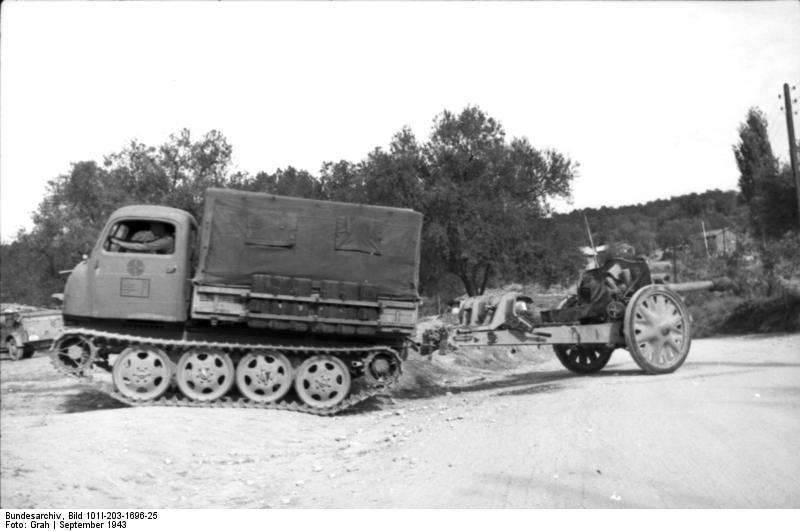
Tractor RSO with a gun in tow. Photo of Wikimedia Commons
The idea of creating a self-propelled gun based on an artillery tractor appeared in the first months of 1943. Preliminary calculations showed that the RSO characteristics will allow not only to tow some guns, but also to transport them on the cargo area. Such processing of the tractor allowed to significantly increase the mobility of artillery units, eliminating the deployment of guns to the position and preparation for leaving after the shooting. By the middle of the summer of 43, the company Steyr-Daimler-Pooh prepared a draft anti-tank self-propelled gun on the basis of a tractor and an 75-mm anti-tank gun PaK 40. In addition, other options were proposed, both anti-tank and anti-aircraft.
One of the main tasks of the new project was to preserve maximum unification with the basic tractor, which made it possible to reduce the cost of producing self-propelled guns. Because of this, the car has retained most of the units of the hull and body with folding sides. At the same time, the cockpit had to be seriously reworked. The first version of the project meant equipping the cabin with several armor plates and installing the gun in the body on a relatively high pedestal, so that you could fire on top of the cab. However, such a proposal was not approved by the customer due to the senseless increase in the size of the combat vehicle. In this regard, in the future were proposed a new gun installation and a smaller cabin. The chassis, however, was again not being finalized.
In the early stages of the project, there was also a proposal to use tool holders to remove it from a tractor and use it as a towed vehicle. Such a proposal could make sense from a tactical point of view, but its implementation was associated with a serious complication of the SAU design and, as a result, with an increase in the cost of production. For this reason, the final draft of the removal of the gun was not provided.
When creating an anti-tank self-propelled tractor RSO has undergone minimal changes. It can be said that all the available aggregates located below the cargo area were saved. Everything that was above has undergone some modifications, but they were not significant due to the need to simplify the design as much as possible.
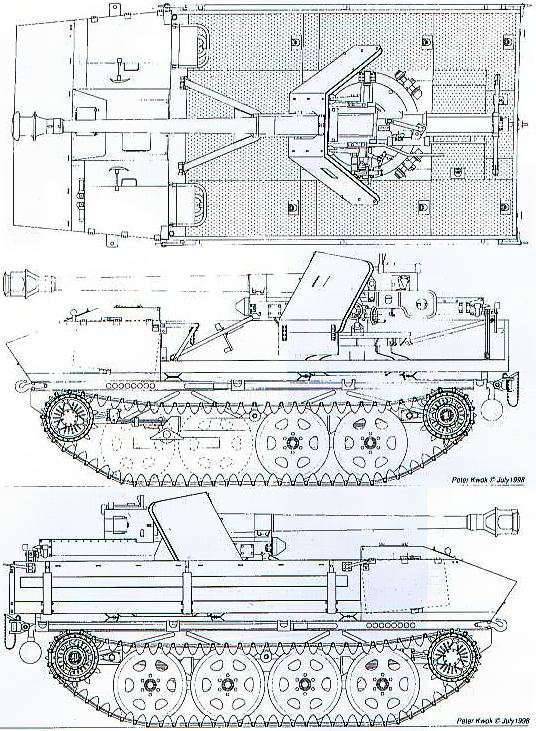
Scheme SAU. Figure Vn-parabellum.com
The ACS on the basis of the Raupenschlepper Ost has retained the chassis of a small height, on the sides of which the tracks were located. An eight-cylinder V-engine with an 80 horsepower, should be installed inside the hull. It should be noted that initially RSO was packaged only with Steyr engines, but later a version with a KHD F4L 514 engine, produced by Klöckner-Humboldt-Deutz AG, appeared. Regardless of the type of engine, the tractor received a mechanical transmission that transmitted torque to the front wheel drive.
The basis of the undercarriage were four pressed support rollers on each side with suspension on leaf springs. The machine was equipped with a small track with tracks 340 mm wide. To save expensive materials, it was planned to manufacture tracks from unalloyed steel. In addition, unlike the German semi-tracked vehicle, the RSO did not have rubber pads on the tracks.
In the original version, the Raupenschlepper Ost was equipped with light cabs of several versions. They had a different shape and size, from a full-fledged “car” cabin to a simplified, assembled from several straight panels. Due to the need to reduce the size of self-propelled guns and because of the construction of the gun installation systems, engineers at Steyr-Daimler-Puch had to develop a new version of the cabin. It was a metal box of relatively low height, open at the top and without a roof. The sides provided two doors for the driver and his assistant. In order to provide at least some protection for the crew when working at the leading edge, the cabin was made of armor 5 mm thick.
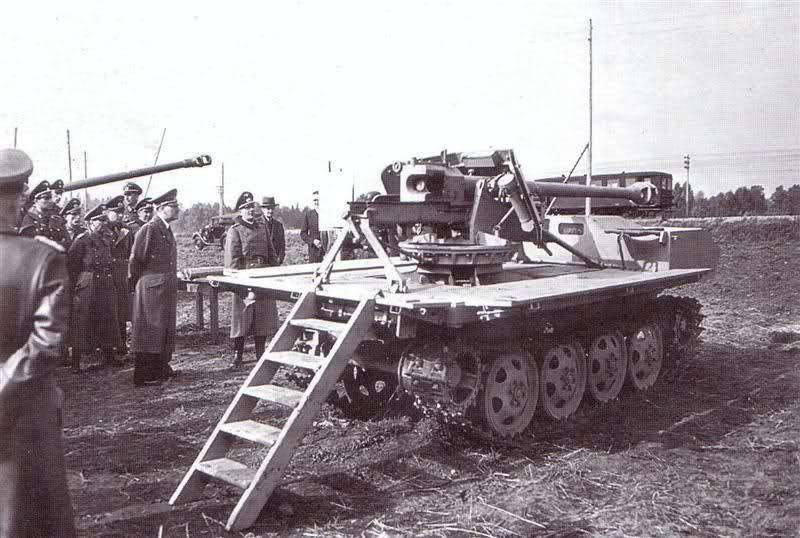
Demonstration of the prototype of the leadership of the country and the army. Photo Militaria-nations.forumbreton.com
In the center of the cargo area of the tractor placed the system for the installation of anti-tank gun PaK 40. To simplify the project, a support device was installed on the metal frame with wooden flooring, on which the ready gun carriage of the gun, which had lost some parts, was to be fixed. With all the simplicity of the design, such an installation system made it possible to aim the gun within fairly wide sectors.
As the main and only staff weapons for the new self-propelled gun was chosen anti-tank gun PaK 40 caliber 75 mm. This gun had a barrel with a length of 46 calibers with a developed muzzle brake, which made it possible to accelerate the sabot projectile to speeds above 930 m / s. The energy of such a projectile was sufficient to penetrate 154 mm of armor at a distance of 500 m. The body of the gun was mounted on a carriage with the possibility of horizontal pickup within a sector of width 65 ° with vertical angles from -5 ° to + 22 °.
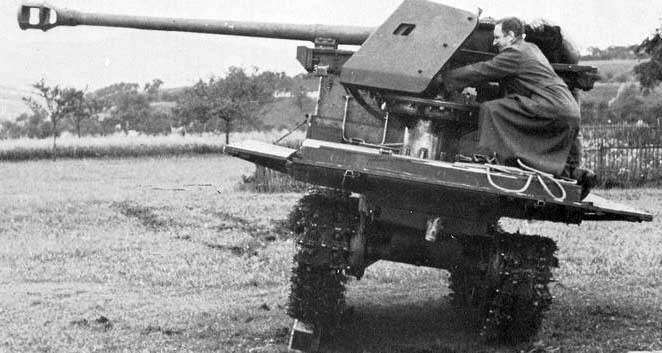
Check the tools. Photo Aviarmor.net
For installation on a self-propelled chassis, the gun has lost some parts, primarily the bed and the wheel travel. At the same time, updated means of fastening the gun on the chassis platform appeared. The gun itself, recoil devices, guidance mechanisms and armor shield remained unchanged. For aiming the guns, it was proposed to use hand-operated mechanisms, as well as standard telescopic and panoramic sights. The ammunition consisted of 28 shells laid in several racks.
The cargo platform of the basic tractor retained the folding sides, which were proposed to be used to increase the area available for calculating the implement. With the open sides of the calculation of the gun could fire in any direction, while remaining under partial protection of the existing gun shield. If necessary, it was possible to shoot with raised sides, but in this case the target had to be in the forward hemisphere within a sector of width 65 °. On the sides of the body could be installed special framework for the awning. The latter could protect the gunners from precipitation, but, like raised sides, limited the angles of horizontal guidance.
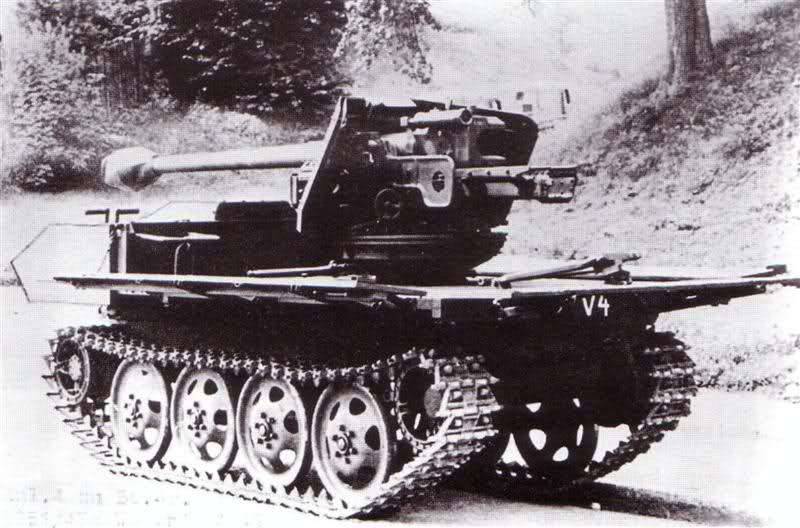
Self-propelled gun in the combat position. Photo Militaria-nations.forumbreton.com
The resulting combat vehicle had a mass at the level of 5200 kg. Due to the use of a new cabin and ready-made installation systems for the gun, the overall height of the self-propelled gun was reduced to 2,6 m. The crew was to consist of four people. The car had the opportunity to reach speeds of up to 20-25 km / h and to overcome at one fuel station to 300 km. In addition to transporting its own gun, ACS retained the ability to tow a trailer weighing up to 2 t, for example, another gun.
According to some data, in the summer of 1943, the company-developer built several prototypes of the new ACS, which differed from each other in various features. So, it is known about the existence of machines with different designs of an armored crew cabin. On some self-propelled guns, the frontal part of the cabin was made with a wedge-shaped profile, while others received a box-shaped unit with an inclined frontal sheet. Most of the cars built had a cabin of the first option.
The project was completed by the mid-summer of 1943. In August, he received the approval of the command, which allowed him to proceed to the assembly and testing of experimental equipment. Inspections continued until the end of September, three prototypes were involved in them. During the tests, some problems peculiar to the new technique were revealed. Soon the deficiencies were fixed.
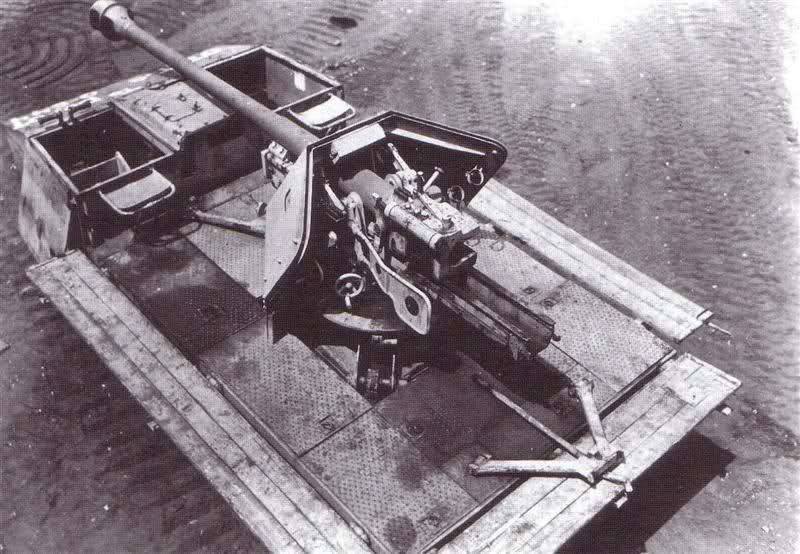
View from above. Photo Militaria-nations.forumbreton.com
Despite the existence of only three prototypes and unfinished tests, October 1 decided to launch mass production. Plants engaged in the construction of Raupenschlepper Ost, also had to master the assembly of self-propelled guns. For the tests required to build at least 50 machines. In 1944, they were going to start serial production with a volume of up to 400 units per month. However, it was first required to carry out the entire required test cycle, as well as to prepare production facilities.
Factory tests of self-propelled guns were completed only in January 1944 of the year. At the same time, short military tests were conducted, according to the results of which the machine was commissioned and a plan for serial construction was drawn up. In accordance with the accepted nomenclature, when adopting the new ACS, it received the designation 7,5cm Pak 40 / 4 auf gep. Selbstfahrlafette Raupenschlepper Ost, reflecting its main elements - the PaK 40 cannon and the RSO tractor.
Military tests of 60 built pre-production batch vehicles were carried out in units of the 16th and 18th armies. It is noteworthy that the new self-propelled guns was originally proposed as a means of reinforcing infantry, but experimental equipment was sent to tank units due to the shortage of other machines. The full use of the proposed equipment in the same battle formations with tanks and assault guns was hindered by low speed and poor protection. However, in the original role, these machines could successfully solve the tasks. In addition, the command was already interested in them, determined to launch full-fledged serial production.
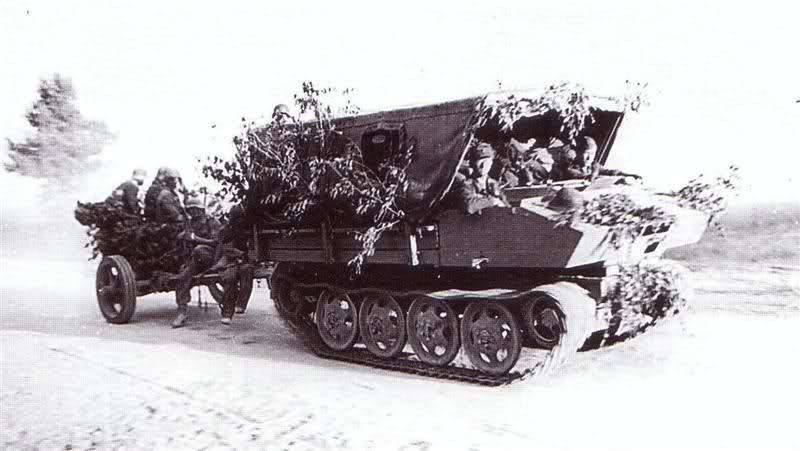
Self-propelled gun at the front. Own gun and the calculation took refuge under the tent with a disguise, in tow the second gun with the calculation. Photo Militaria-nations.forumbreton.com
The initial plan for serial construction implied the release of the first batch of self-propelled guns in March 44. It should consist of 50 machines. From April to June, the monthly issue was to grow by fifty units. Finally, since July, the troops were to receive 400 ACS per month.
Project 7,5cm Pak 40 / 4 auf gep. Selbstfahrlafette Raupenschlepper Ost received the support of some German leaders, but this did not help him reach full-fledged mass production. The fact is that in the middle of autumn 1943, before the completion of all the necessary tests, the company-developer proposed a project to modernize the existing equipment. Through the use of certain innovations planned to improve performance. It was proposed to launch the release of upgraded machines in 44. In connection with the appearance of such a proposal, disputes began on the future of the two projects, which ultimately had a negative impact on both developments.
Due to the uncertainty with the plans and the general difficulties of the industry, the batch production of the ACS 7,5cm Pak 40 / 4 auf gep. Selbstfahrlafette Raupenschlepper Ost never started. The release was limited to 60 machines assembled for military testing. This technique continued to be used for some time by combatant units until it was incapacitated or replaced by newer and more advanced machines.
The exact combat path of six dozen self-propelled guns is unknown, but there is evidence of the final fate of the built vehicles. Most of this technology was lost in the battles or sent to the smelting as superfluous. Up to our time, at least two units of this technology have survived. Like many other rare war machines of the past, they became museum pieces.
7,5cm Pak 40 / 4 auf gep self-propelled gun project. The Selbstfahrlafette Raupenschlepper Ost is a curious example of how trying to simplify a technique to the maximum and facilitate its production leads to unexpected results. The excessive simplicity of the design, with all its advantages, led to an insufficient level of protection and survivability of the self-propelled gun. In addition, due to the actual shutdown of the project after the assembly of the pre-production batch, all the advantages associated with simplifying the construction and construction were simply not realized and did not yield the expected results. Thus, the Wehrmacht received a small number of combat vehicles with anti-tank guns, hardly able to fully solve the tasks or change the course of the war. However, the project has already led to a waste of time and resources, further worsening the situation of Nazi Germany.
On the materials of the sites:
http://aviarmor.net/
http://vn-parabellum.com/
http://achtungpanzer.com/
http://lonesentry.com/
http://clubhyper.com/
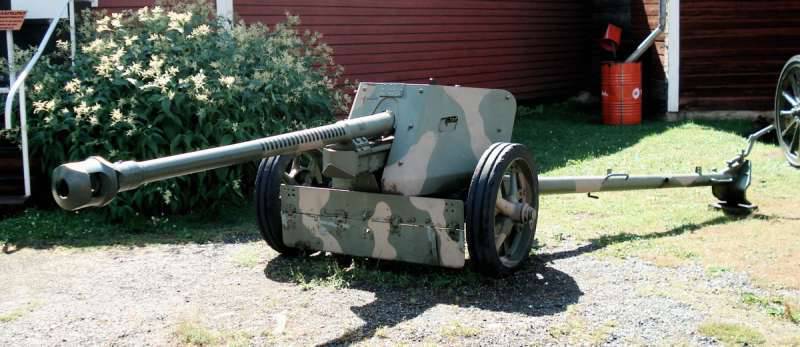
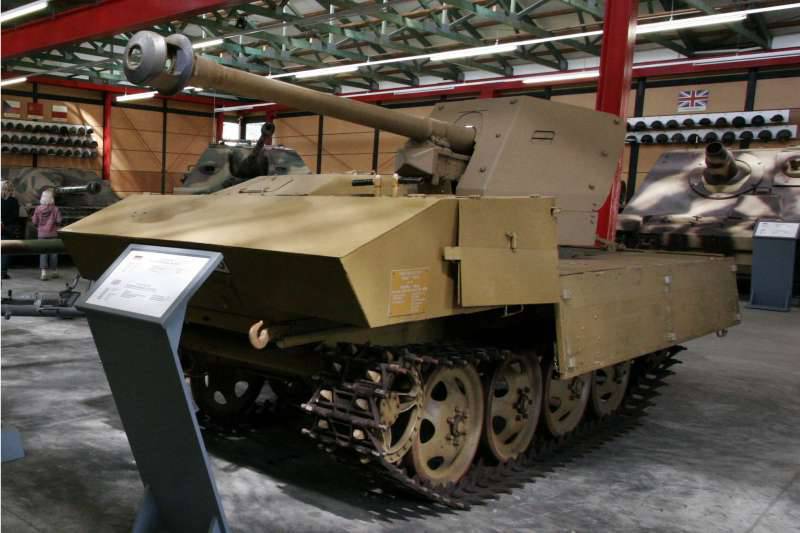
Information